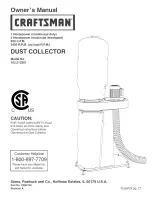
C. Duct Work Recommendations
The maximum CFM rating for each model dust collector
should be greater than the minimum required CFM as
listed in the
Exhaust Volumes Required for Different
Applications
chart on page 7.
If you will be connecting the dust collector into a piping
system for more than one machine, the dust collectors
maximum CFM should be greater than the minimum CFM
required for each machine in the system. If the piping
system will have slide gate dampers at each machine, with
only one machine operating at a time, then the dust
collector can handle more machines as long as the CFM
required does not exceed the maximum CFM of the dust
collector. As a rule of thumb, one dust collector can handle
multiple machines as follows:
Model 33S & 50S
..One machine only.
Model 75S
...........Two machines if within 5 feet of each other.
Model 100S
.........Two machines if within 10 feet of each other.
Model 150S
.........Two machines if within 20 feet of each other.
Model 200S
.........Up to 30 feet of 5” duct, and 3 machines.
Model 300S
.........Up to 75 feet of 5” duct, and 3-4 machines.
NOTE:
The number of machines you can collect from will depend on
the CFM required per machine.
General Recommendations for Ductwork Systems:
1. The National Fire Protection Agency (NFPA) will no
longer permit a single dust collector to be used to
collect
BOTH
wood dust or chips
AND
metal dust or
chips because of the possibility of a fire and/or
explosion.
2.
DO NOT use any PVC pipe or flexible hose for
duct work.
This is no longer permitted by the
National Fire Protection Agency (NFPA). Dust
traveling through PVC pipe or hose can build up a
static electric charge.
3. Limit the use of flexible hose in any duct work to as
little as possible. The pressure drop (resistance)
through flex hose can be 2-3 times greater than
smooth wall sheet metal pipe.
4. If connecting a dust collector to more than one
machine, you should install slide gate dampers at
each machine so the dust collector is only pulling
from one machine at a time.
5. Keep the number of duct elbows to a minimum. A
90° elbow has the same pressure drop (resistance)
as 10 feet of straight pipe.
6. Estimate 2 CFM reduction in air flow for each foot of
straight pipe and 20 CFM reduction for each 90°
elbow.
7. Pneumatic conveying of wood dust requires a
minimum air velocity of 3500 feet per minute (FPM)
in the duct or hose. For metal dust, the velocity can
be from 3500 FPM to 4500 FPM. Velocities less than
these will allow the dust to settle in the duct work or
hose. Therefore, the CFM must not be reduced
below these velocities.
8. Connect the dust collector inlet hose to the
connector port built into the dust producing machine.
If there is no port on the machine, place the inlet
hose and inlet nozzle as close as safely possible
where it will collect the most dust.
9.
DO NOT
use any duct or hose smaller than 3”.
D. Electrical
All electrical connections and wiring must be
performed by qualified personnel or a licensed
electrician.
Models 33S, 50S, 75S and 100S, with single
phase, TEFC motors are pre-wired at the factory with a
cord, plug and switch to operate on a 115 Volt, 1 Phase, 60
Hertz power supply. These motors are also connected for
the proper blower wheel rotation.
All other motors must be wired by the user for the
operating voltage as stated on the motor nameplate and
wiring diagram.
All wiring must be in accordance with
Underwriters Laboratories (UL) and the National
Electric Code (NEC).
After all wiring is properly
completed, apply power to the motor for 1-2 seconds and
then turn it off. As the motor slows down, observe the
rotation of the motor cooling fan on top of the motor. The
proper rotation for all dust collector motors is Clockwise
(CW)
when looking down on top of the motor. If the motor
is turning Counter-Clockwise
(CCW)
, lock out the power to
the motor and then make the wiring changes per the motor
wiring diagram either on the motor nameplate or inside the
motor conduit box.
VI. OPERATION
The only operation steps that need to be monitored are
emptying the can or drum and the dust bag. The can or
drum should never be allowed to become over 1/3 full. The
bag should never be more than 1/4 full.
8


































